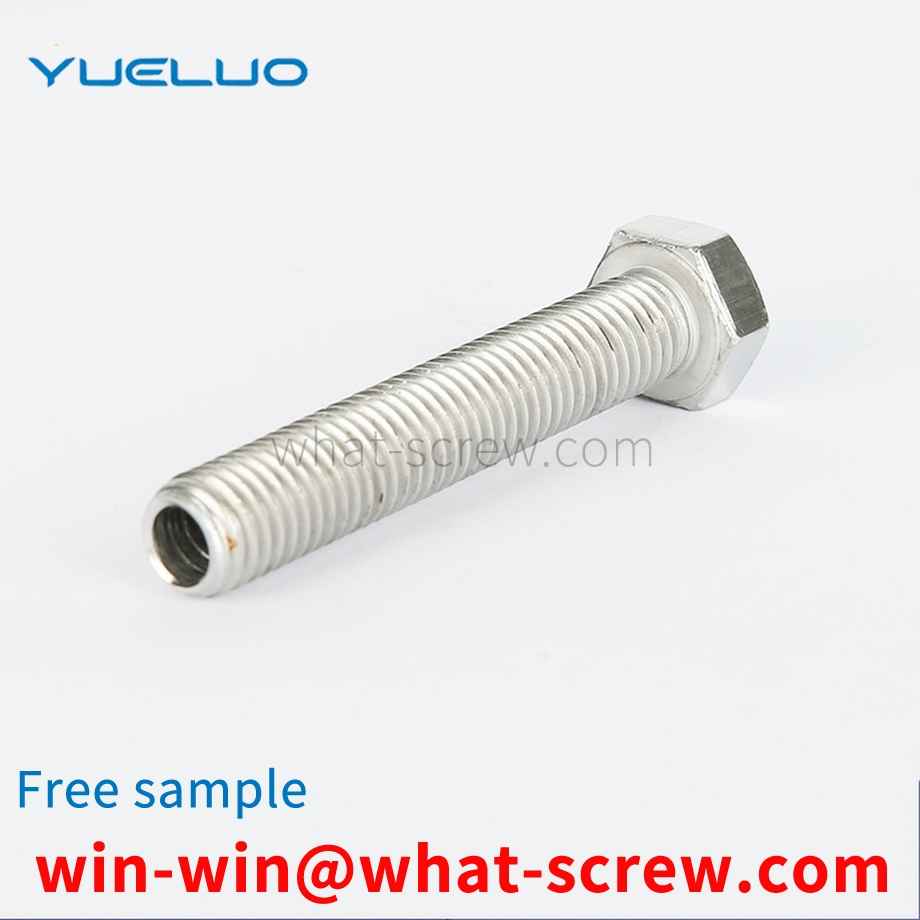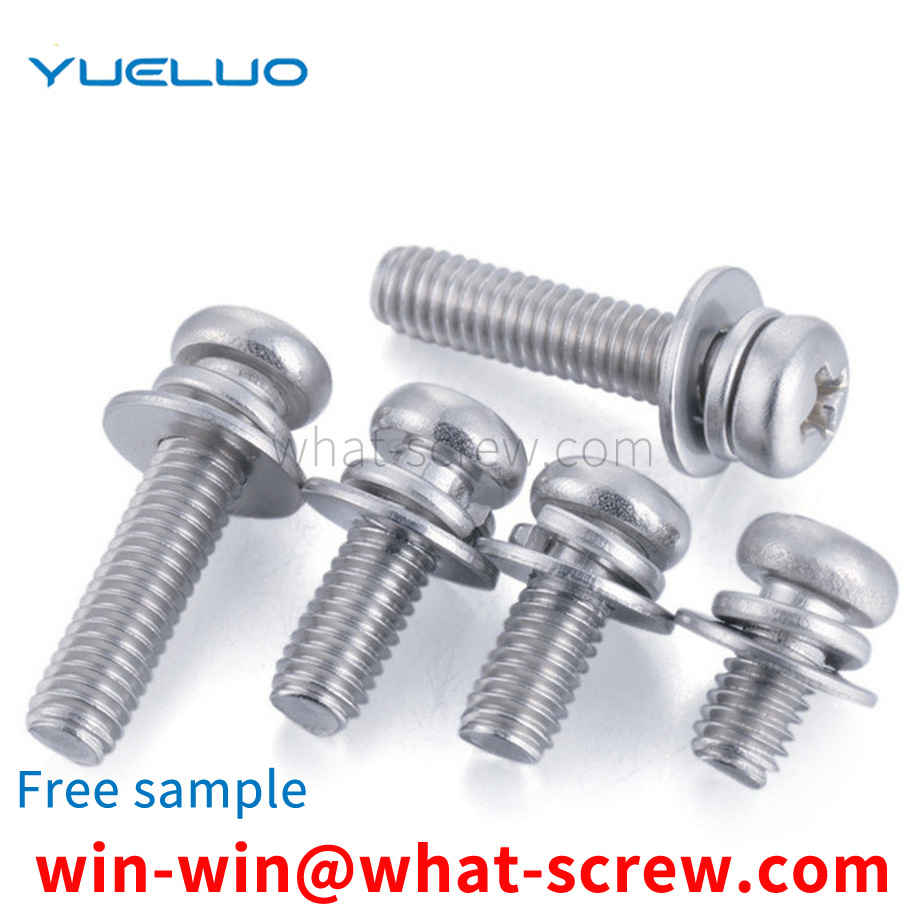The common types of wood screws are iron and copper, and the types are divided into round head type and other samples of wood screws according to different nail heads. There are two types of slotted screws and cross recessed screws. Generally, the round head screws are made of mild steel and are blue, and the flat head screws are polished. The oval head screws are usually plated with cadmium and chrome, and are often used to install hinges, hooks and other hardware accessories. Specifications are determined by rod diameter, length and nail head type. [1]
Due to manufacturing and installation errors, the lamp head and its connecting part of the shadowless lamp will drift, which cannot be positioned at any position. Therefore, in the shadowless lamp, the damping force is usually provided by the damping screw to realize the positioning of the lamp cap and its connecting part. The damping screw needs to be able to provide a suitable damping force. The damping force should not be too small to meet the positioning requirements; at the same time, the damping force should not be too large to make the user feel comfortable when moving the lamp head and its connecting parts. In addition, within the normal life range, after the damping screw is worn, it should also be able to provide sufficient damping force to satisfy the positioning of the lamp cap and its connecting part. The damping screw is tightened by the thread, the top pressure disc spring is deformed, and the disc spring presses the friction end to generate frictional force, thereby providing an effective and lasting damping force. The damping force can be realized by adjusting the screw tightness. For the friction ends, there are certain requirements for wear resistance, certain self-lubrication, certain strength, hardness and toughness. At present, the friction end materials in the industry mainly include metals such as brass and tin bronze; non-metals such as nylon and POM. At present, the main disadvantage of the friction end of the damping screw is that it is easy to produce abnormal noise during the friction process for metal materials. For non-metallic materials, deformation is easy to occur and the strength is insufficient.
Flat gaskets are usually thin pieces of various shapes used to reduce friction, prevent leakage, isolate, prevent loosening, or distribute pressure. There are such components in many materials and structures. The existing flat washer has a simple structure design. After long-term use, the phenomenon of thinning of the thickness is likely to occur, which in turn leads to poor wear resistance of the flat washer.
Various stainless steel materials have different properties due to their different material contents, so the corrosion resistance is also different. The following is a brief explanation of several commonly used materials: 304 is a universal stainless steel, which is widely used in the production of good requirements. Equipment and components with comprehensive properties (corrosion resistance and formability). 301 stainless steel exhibits obvious work hardening phenomenon during deformation, and is used in various occasions requiring higher strength. 302 stainless steel is essentially a variant of 304 stainless steel with higher carbon content, which can obtain higher strength by cold rolling. 302B is a kind of stainless steel with high silicon content, which has high resistance to high temperature oxidation. 303 and 303Se are free-cutting stainless steels containing sulfur and selenium, respectively, and are used in applications where free-cutting and high surface finish are mainly required. 303Se stainless steel is also used to make parts that require hot upsetting, because under these conditions, this stainless steel has good hot workability. 304L is a lower carbon variant of 304 stainless steel used where welding is required. The lower carbon content minimizes carbide precipitation in the heat-affected zone near the weld, which can lead to intergranular corrosion (weld erosion) of stainless steel in some environments. 304N is a nitrogen-containing stainless steel, and nitrogen is added to increase the strength of the steel. 316 (18Cr-12Ni-2.5Mo) material: due to the addition of Mo, its corrosion resistance, atmospheric corrosion resistance and high temperature strength are particularly good, and can be used under harsh conditions; excellent work hardening (non-magnetic).
T-bolt is a common fastener, which is mostly used where there is a T-slot on the workbench or where the connection can only be made from the side to be connected. However, it has the following problems in the actual production and processing process. 1. The T-bolt manufactured according to the current GB37-88 is used in conjunction with the T-slot on the worktable, which is easy to damage the T-slot on the worktable. 2. According to the observation and investigation, it is found that 90% of the damage to the T-bolt manufactured by GB37-88 is thread damage during use, and the T-shaped part is rarely damaged, resulting in a waste of raw materials. SUMMARY OF THE INVENTION The purpose of the present invention is to solve the problem that the current composite T-bolt is easy to damage other equipment and cause waste of raw materials in the actual use process, and to provide a simple structure, easy to use, safe and reliable, and not easy to damage other equipment. , thereby saving raw materials and other advantages of composite T-bolts. In order to achieve the above purpose, the present invention adopts the following technical scheme: a composite T-bolt, which includes a bolt, and one end of the bolt is connected with the T-shaped block cockroach. The T-shaped block is provided with a tapered hole, and the connection between the bolt and the T-shaped block is a cone, which is matched with the tapered hole. The utility model combines the two parts of the T-shaped block and the threaded bolt through the T-shaped block and the taper hole and the cone on the bolt to automatically lock the two parts before use. When the threaded part of the bolt is damaged, only the threaded bolt needs to be replaced. That's it. Compared with the domestic T-shaped bolts currently produced in the manufacturing process, the utility model solves the problems of complicated manufacturing processes and waste of raw materials. It is well known that the manufacture of T-bolts requires processing such as forging, turning, milling, and heat treatment. Since the composite T-bolt is used in combination with the T-block and the bolt, and the T-block is rarely damaged, after purchasing or manufacturing the T-block once, you only need to purchase or manufacture the bolt in the future. Compared with the T-bolts currently produced in China, the composite T-bolts can better protect the T-slots on the working surface. Because the T-bolt currently produced in China will rotate a certain angle around the axis of the T-bolt when fixing the object, the T-bolt will rotate at a certain angle, thereby reducing the contact between the T-bolt T-shaped surface and the T-slot stress surface of the working face. surface, causing stress concentration on this surface. The composite T-bolt avoids the above problems due to the increase of the guide surface, thereby protecting the T-slot. The beneficial effects of the utility model are: 1. Saving raw materials. 2. Reduce processing costs. 3. Simplify the technological process. 4. Protect the T-slot.
We have many years of experience in the production and sales of screws, nuts, flat washers, etc. The main products are: anti-loose and anti-skid, aluminum alloy coupling long nuts, plastic spacers, expansion hook and ring screws and other products, we can provide you with suitable tightening Firmware Solutions.



















 Service Hotline
Service Hotline




